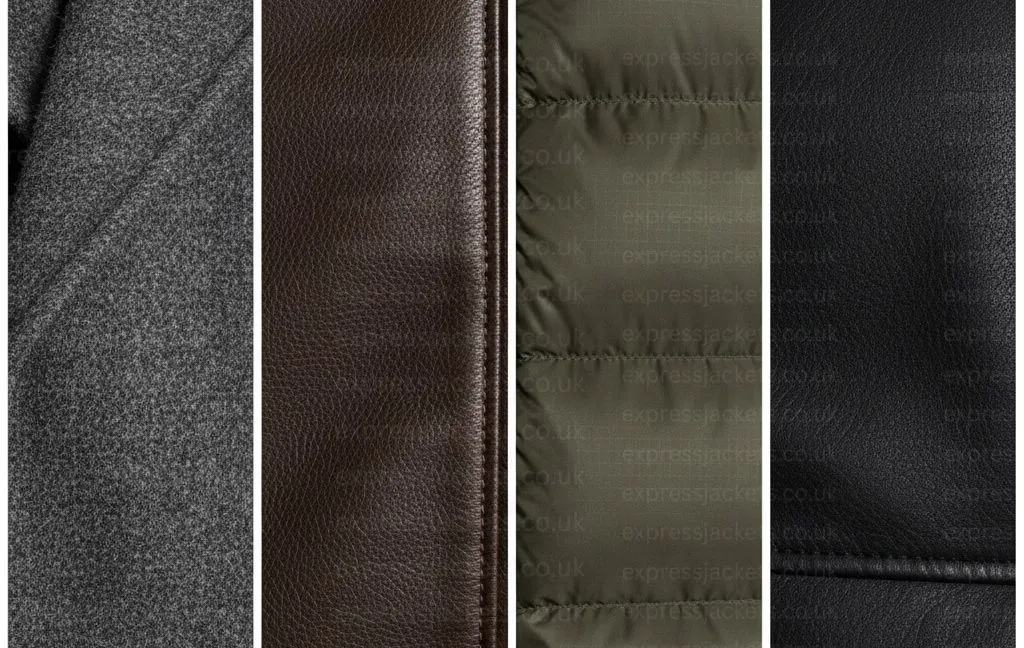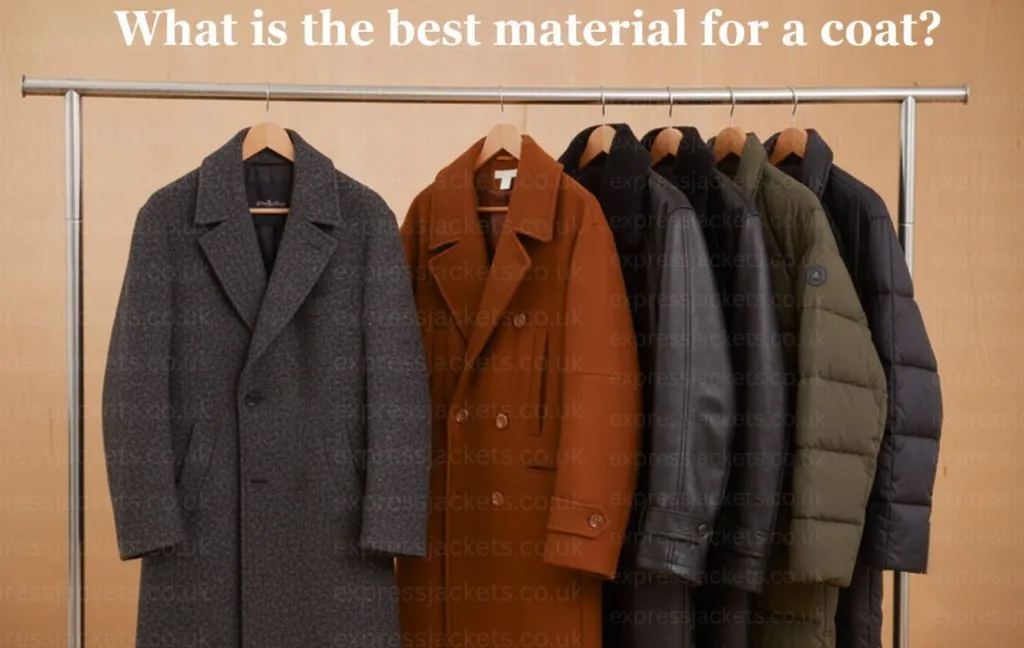The issue of what material for your best coat is a very individual choice which is based on your climate, lifestyle, and how much warmth you require. Do you live in an area that sees heavy rain and snow which requires a greater degree of protection? Are you more into the look and feel of a breathable material for wear in the city? Do you value classic look and wearability above all? From the rich fullness of natural wool to the tech performance of man made down, in knowing the attributes of each material is your ticket to choosing the perfect outerwear. We put together this guide which does a in depth comparison of the top winter coat materials which we break down by pro and con we also look at the natural fibers, high tech synthetics, and versatile leathers to help you in your quest for that ideal next coat.
The Natural Classics: Wool, Leather, and Cotton Are Also Which of Which.
Classic outer wear has as its base natural materials that for generations have protected us from the elements. These natural fibers present in wool and other heritage materials also bring with them unique features in terms of breathability, insulation, and how they fall on the body. Wool Street Coat is put forward as the preeminent material for warm coats and is an expert at thermal regulation. Its structure has natural crimp in the fibers’ make up that creates millions of small air pockets which in turn trap body heat for very effective warmth without the over the top bulk. Also wool has a natural water resistance and moisture wicking properties which out perform cotton that only begins to feel wet when it has absorbed 30% of its weight in moisture. This feature makes wool a great option for cold and damp weather. For the ultimate in warmth look to dense weaves of Cashmere (although not as durable) or the heavy duty Melton wool which is very wind resistant.
Leather Costume Coat is a perfect material for style, durability and robust wind protection. It has a dense non-porous structure which makes it almost 100% windproof and so gives instant protection in stormy conditions. High quality real leather (cowhide, lambskin etc. improves with age to develop a unique patina which adds character and longevity thus setting it out as a true lifetime investment. Although a thin leather shell doesn’t provide much insulation by itself a coat with a thick lining of shearing or quilted polyester does an excellent job of keeping you warm in cold weather by creating a great barrier against the external wind and cold.
Cotton is an extremely versatile and popular natural fiber but it has a large issue with respect to cold weather gear. It is very soft and breathable which makes it great for mild and dry weather where it does an excellent job of wicking away body heat. But the main issue is that it is hydrophilic it absorbs moisture very quickly and retains it. Once wet cotton loses its insulation completely and in fact draws heat away from the body which is why we have the saying “cotton kills” in extreme outdoor settings. Thus cotton works best for garments meant for use in mild climates like trench coats or light cotton coat unless it is heavily processed with wax or synthetic coatings which improve its water resistant properties.
The Modern Heroes: Puff and Synthetics.
In the present time we see that which modern textile tech has brought to us materials designed for outstanding warmth, light weight performance, and also better water resistance that which forms the base of today’s functional outer wear. That which is the insulating core of any puffer coatis its filling which can be either natural down or synthetic fiber. This choice which is a key element in the design of the coat plays a large role in how it does in wet weather.
Full Comparison:
- Natural Down (Goose/Duck): This has the best warmth to weight ratio out there. We see great air trapping fluffiness which in turn provides very efficient insulation. In terms of performance we measure the warmth by its Fill Power (for instance 800 fill is very premium). Also a large issue is that down almost completely loses its insulating value when wet which makes it a no go in heavy rain unless it is put in a waterproof shell.
- Synthetic Fill (Polyester/PrimaLoft): These we have put forward as man made polyester fibers which we designed to have the same air trapped structure as down. We find that their main benefit is they maintain warmth when wet and that they dry at a faster rate. Thus we see synthetics as the better choice for very wet or unpredictable environments. Disadvantage is that they tend to be heavier and bulk out more than natural down at the same level of warmth.
Technical outerwear tends to use high tech synthetics like Nylon or Polyester for their shell. These materials are light in weight, very durable, and also it is key that they may be put through treatments (like DWR) or integrate advanced membranes (like Gore-Tex) which in turn provides full protection from wind and water while still allowing for breathability. This technical ability is what puts them at the top for functional outerwear, rain coats, and ski shells which we require to control internal and external moisture.

Finally we see that which we term Faux Leather usually Polyurethane or PU is put forth as a more affordable and easy care option to natural leather. It does a fair job at wind proofing and in that it succeeds in presenting a similar look to that of natural skin. But what it lacks in breathability it makes up for by which it causes the wearer to heat up and sweat rather quickly. Also it is not as strong as real leather and does not improve with age as natural products do; instead what we find is that it begins to crack and peel off after a few seasons.
Choosing Your “Best”: A Practical Guide.
A winter down coat what you turn to for great lightweight warmth in dry cold, heavy wool is best for that classic look and feel in damp cold weather and for top protection against rain and wind you’ll want a technical synthetic shell. Also when it comes to investment pieces put function before fashion.
Frequently Asked Questions (FAQs):
Q1: Is wool truly waterproof for heavy rain and snow?
A: No, wool doesn’t repel water completely it is water resistant and does a good job with light rain or snow which it will shake off for a while. In heavy rain though it will let in moisture and end up wet.
Q2: Which is warmer: leather or a puffer coat?
A: A puffer coat does better in cold weather as it has insulating air pockets which trap in heat, leather on the other hand does a better job at blocking wind and has little thermal insulating quality.
Q3: 3. Is cotton good material for cold weather?
A: No, cotton is not a great material for cold weather it does what is called moisture retention and also dries slowly which in turn may leave you feeling cold instead of warm.
Q4: Is faux leather or real leather more durable for everyday wear?
A: Real leather does better in day to day wear it outlasts, is resistant to cracking, and improves with age; faux leather tends to fall apart or peel over time.
Q5: Why should I choose a coat from Express Jackets , given all these material options?
A: At Express Jackets you can find what you are looking for in a coat they are known for their fine craftsmanship, use of high quality materials which suit the UK climate, and design which is at once tough and trendy so whether you go for the leather, cotton, faux, or a hybrid option you’ll get durable and fashionable outerwear.

